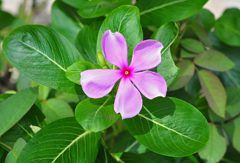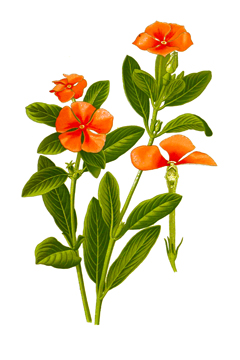 |
|
https://edibleplants.org/ |
 |
| https://edibleplants.org/ |
Translate this page:
Summary
Madagascar Periwinkle or Cataranthus roseus is an evergreen shrub of about 1 m tall and 1 m wide. It is a flowering plant native to Madagascar. The leaves are oval to oblong, broad, glossy, green, and arranged in opposite pairs. The flowers have five petal-like lobes and are white to dark pink with a darker red centre in colour. It is commonly grown as an ornamental plant but it has long been used in traditional medicine. It has shown to have activity against leukaemia and other cancers. Different plant parts and forms are used in the treatment of various diseases such as hypertension, asthma, menstrual irregularities, dengue fever, chronic constipation, diarrhoea, indigestion, malaria, etc.
Physical Characteristics

 Catharanthus roseus is an evergreen Perennial growing to 0.7 m (2ft 4in) by 0.7 m (2ft 4in) at a fast rate.
Catharanthus roseus is an evergreen Perennial growing to 0.7 m (2ft 4in) by 0.7 m (2ft 4in) at a fast rate.
See above for USDA hardiness. It is hardy to UK zone 9 and is frost tender. The flowers are pollinated by Butterflies. The plant is self-fertile.
It is noted for attracting wildlife.
Suitable for: light (sandy), medium (loamy) and heavy (clay) soils, prefers well-drained soil and can grow in nutritionally poor soil. Suitable pH: mildly acid, neutral and basic (mildly alkaline) soils and can grow in very acid, very alkaline and saline soils.
It can grow in semi-shade (light woodland) or no shade. It prefers moist soil and can tolerate drought.
UK Hardiness Map
US Hardiness Map
Synonyms
Ammocallis rosea (L.) Small Lochnera rosea (L.) Rchb. ex Endl. Pervinca rosea (L.) Gaterau Vinca gul
Plant Habitats
Edible Uses
Edible Parts: Leaves
Edible Uses: Tea
A tea is made from the leaves.
References More on Edible Uses
Medicinal Uses
Plants For A Future can not take any responsibility for any adverse effects from the use of plants. Always seek advice from a professional before using a plant medicinally.
Antiasthmatic Antidiarrhoeal Antiseptic Cancer Depurative Diaphoretic Diuretic Emetic
Hypoglycaemic Hypotensive Laxative Malaria Purgative Skin Stings
Vermifuge
Madagascar periwinkle has long been used as a traditional medicine. Tests by pharmaceutical companies in the 1950's showed the presence of a number of medically active alkaloids, especially the compound vincristine, which has been shown to have activity against leukaemia[ 238 , 254 , 302 ]. The alkaloids, when isolated from the plant, are highly toxic but have also been shown to reduce the numbers of white blood cells, leading to applications which have revolutionized conventional cancer therapy[ 238 ]. The plant is cultivated as a source of these alkaloids, a number of which are extracted and used allopathically[ 299 ]. The isolated alkaloids are used to treat and other cancers[ 238 ]. The alkaloids vincristine and vinblastine are prescribed in anticancer therapy, particularly in cases of acute leukaemia (especially in children) and Hodgkin's lymphoma. They are usually part of a complex chemotherapy protocol[ 299 ]. Used in isolation, they have a number of side-effects, including alopecia, nausea and bone marrow depression[ 238 ]. The dried root is an industrial source of ajmalicine, which increases the blood flow in the brain and peripheral parts of the body. Preparations of ajmalicine are used to treat the psychological and behavioural problems of senility, sensory problems (dizziness, tinnitus), cranial traumas and their neurological complications[ 299 ]. The leaves and aerial parts of the plant have a wide range of traditional uses. Well known as an oral hypoglycaemic agent, the plant is also considered to be depurative, diaphoretic, diuretic, emetic, purgative and vermifuge. A decoction is taken to treat hypertension, asthma, menstrual irregularities, chronic constipation, diarrhoea, indigestion, dyspepsis, malaria, dengue fever, diabetes, cancer and skin diseases[ 238 , 299 , 348 ]. Extracts prepared from the leaves have been applied externally as antiseptic agents for the healing of wounds; to relieve the effects of wasp stings; against haemorrhage, skin rash and as a mouthwash to treat toothache[ 299 ]. The leaves are harvested when the plant is flowering, and can be dried for later use[ 238 ]. An infusion of the flowers is used to treat mild diabetes[ 348 ]. A decoction of the roots is taken to treat dysmenorrhoea[ 299 ].
References More on Medicinal Uses
The Bookshop: Edible Plant Books
Our Latest books on Perennial Plants For Food Forests and Permaculture Gardens in paperback or digital formats.

Edible Tropical Plants
Food Forest Plants for Hotter Conditions: 250+ Plants For Tropical Food Forests & Permaculture Gardens.
More

Edible Temperate Plants
Plants for Your Food Forest: 500 Plants for Temperate Food Forests & Permaculture Gardens.
More

More Books
PFAF have eight books available in paperback and digital formats. Browse the shop for more information.
Shop Now
Other Uses
Fodder
Other uses rating: Low (1/5). Other Uses: Cultivated as an ornamental. A bedding plant in temperate gardens. Noted for its long flowering period. This plant is attractive to bees, butterflies and/or birds.
Special Uses
Attracts Wildlife Carbon Farming
References More on Other Uses
Cultivation details
Hypothetical Crop Management: Hay
A plant of the tropics and subtropics, it can also be cultivated as an annual crop in warm temperate areas[ 418 ]. It grows best in areas where annual daytime temperatures are within the range 20 - 30c, but can tolerate 10 - 34c[ 418 ]. At temperatures below 5c, some branches or even the whole plant will die. When the temperature rises, the plant will usually regrow from basal axillary buds, especially after hard pruning of the shoots and roots. Without pruning, the plant regrows mainly from the tops[ 299 ]. It prefers a mean annual rainfall in the range 1,000 - 1,200mm, but tolerates 800 - 1,400mm[ 418 ]. Established plants are drought tolerant[ 299 ]. An easily grown plant, it prefers a fertile, moist but well-drained soil in a sunny to partially shaded position[ 302 ]. Usually found on sandy soils in the wild, but sometimes also on rocky soils[ 299 ]. It is very tolerant of salt in the soil[ 299 ]. Prefers a pH in the range 6 - 7, tolerating 5.5 - 7.5[ 418 ]. The plant may become a naturalised weed, especially when growing in dry habitats[ 302 ]. In the tropics, the roots are ready for harvest after one year[ 418 ]. In Hungary, when grown as an annual, average yield is 3.5 - 4.5 tonnes/ha of the fresh herb, or 1 - 1.5 tonnes/ha of dried herb[ 418 ]. Under irrigation conditions, 1.5 tonnes/ha of roots, 1.5 tonnes/ha of stems and 3 tonnes/ha of leaves can be obtained[ 418 ]. The plant is usually self-fertile, but self-incompatible strains exist and can be locally common in the wild[ 299 ].
Carbon Farming
-
Hypothetical Crop
These are perennial plants that could potentially be developed for cultivation. Some, such as cycads (for industrial starch), as simply neglected; others, such as buckwheat and soybeans, are annual crops that could potentially be perennialised by crossing and relatives.
-
Management: Hay
Cut to the ground and harvested annually. Non-destructive management systems maintaining the soil organic carbon.
References Carbon Farming Information and Carbon Sequestration Information
Temperature Converter
Type a value in the Celsius field to convert the value to Fahrenheit:
Fahrenheit:
The PFAF Bookshop
Plants For A Future have a number of books available in paperback and digital form. Book titles include Edible Plants, Edible Perennials, Edible Trees,Edible Shrubs, Woodland Gardening, and Temperate Food Forest Plants. Our new book is Food Forest Plants For Hotter Conditions (Tropical and Sub-Tropical).
Shop Now
Plant Propagation
Seed - sow in a seed tray. Germination takes 15 - 21 days at 21c, with more than 95% of the seed sprouting[ 200 , 299 ]. Seedlings are ready to pot up after 3 weeks[ 299 ]. Seed can remain viable for 3 - 5 years[ 299 ]. Greenwood or semi-ripe cuttings. When rooting hormone is used, the cuttings will start to root after 4 - 5 weeks[ 299 ]. Putting the cuttings in water will also induce rooting, but it will take longer than in the soil[ 299 ].
Other Names
If available other names are mentioned here
Madagascar Periwinkle or Cataranthus roseus. Other common names include Jasmine, Cayenne Old Maid Periwinkle, Rose Vinca, Rose Periwinkle, Cayenne Jasmine, Madagascar Periwinkle, Old Maid, and Vinca. Other Names: Ainskati, Billaganneru, Cape periwinkle, Conchita, Nayantara, Old maid, Phaeng-phuai-farang, Pink Periwinkle, Rosy periwinkle, Sada-phul, Sadabahar, Sudukadu mallikai, Te buraroti, Ushamalari.
Native Range
AFRICA: Madagascar
Weed Potential
Right plant wrong place. We are currently updating this section.
Please note that a plant may be invasive in one area but may not in your area so it's worth checking.
May be a noxious weed or invasive in some areas. Listed as a noxious weed in Western Australia, Australian Capital Territory, and parts of eastern Queensland.
Conservation Status
IUCN Red List of Threatened Plants Status : This taxon has not yet been assessed.

Growth: S = slow M = medium F = fast. Soil: L = light (sandy) M = medium H = heavy (clay). pH: A = acid N = neutral B = basic (alkaline). Shade: F = full shade S = semi-shade N = no shade. Moisture: D = dry M = Moist We = wet Wa = water.
Now available:
Food Forest Plants for Mediterranean Conditions
350+ Perennial Plants For Mediterranean and Drier Food Forests and Permaculture Gardens.
[Paperback and eBook]
This is the third in Plants For A Future's series of plant guides for food forests tailored to
specific climate zones. Following volumes on temperate and tropical ecosystems, this book focuses
on species suited to Mediterranean conditions—regions with hot, dry summers and cool, wet winters,
often facing the added challenge of climate change.
Read More
Expert comment
Author
(L.) G.Don
Botanical References
Links / References
For a list of references used on this page please go here
A special thanks to Ken Fern for some of the information used on this page.
Readers comment
| Add a comment |
|
If you have important information about this plant that may help other users please add a comment or link below. Only comments or links that are felt to be directly relevant to a plant will be included. If you think a comment/link or information contained on this page is inaccurate or misleading we would welcome your feedback at [email protected]. If you have questions about a plant please use the Forum on this website as we do not have the resources to answer questions ourselves.
* Please note: the comments by website users are not necessarily those held by PFAF and may give misleading or inaccurate information.
To leave a comment please Register or login here All comments need to be approved so will not appear immediately.
|
Subject : Catharanthus roseus
|
|
|
|